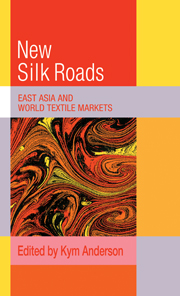Book contents
- Frontmatter
- Contents
- List of figures
- List of tables
- Contributors to this volume
- Preface
- Abbreviations and acronyms
- Symbols
- Introduction and summary
- I FIBRES, TEXTILES AND ECONOMIC DEVELOPMENT
- 1 The changing role of fibres, textiles and clothing as economies grow
- 2 The experience of Japan in historical and international perspective
- 3 Effects of China's dramatic reforms on its neighbours and on world markets
- 4 Thailand's growth in textile and clothing exports
- II DEMAND FOR TEXTILE EXPORTS FROM NEWLY INDUSTRIALIZING ASIA
- III CONCLUSIONS
- Appendix: Data on world production, consumption and trade in textiles, clothing and fibres
- Bibliography
- Index
3 - Effects of China's dramatic reforms on its neighbours and on world markets
Published online by Cambridge University Press: 19 January 2010
- Frontmatter
- Contents
- List of figures
- List of tables
- Contributors to this volume
- Preface
- Abbreviations and acronyms
- Symbols
- Introduction and summary
- I FIBRES, TEXTILES AND ECONOMIC DEVELOPMENT
- 1 The changing role of fibres, textiles and clothing as economies grow
- 2 The experience of Japan in historical and international perspective
- 3 Effects of China's dramatic reforms on its neighbours and on world markets
- 4 Thailand's growth in textile and clothing exports
- II DEMAND FOR TEXTILE EXPORTS FROM NEWLY INDUSTRIALIZING ASIA
- III CONCLUSIONS
- Appendix: Data on world production, consumption and trade in textiles, clothing and fibres
- Bibliography
- Index
Summary
The dramatic reforms to China's economic policies which began in the late 1970s, particularly the opening up of China to international trade and investment, stimulated very rapid growth in this populous economy. During the first decade of the reforms China's real GDP per capita and volume of exports grew at more than 6 and 10 per cent per year, respectively, three times the rates for other developing countries and for the world as a whole and close to the remarkable performance of East Asia's more advanced developing economies. It is true that China still accounts for only about 2 per cent of world GDP and 1 per cent of world exports in aggregate, but for some basic commodities its importance in world markets is much closer to, and in some cases exceeds, the country's 22 per cent share of world population. Food, some minerals and metals, and fibres, textiles and clothing are in that exceptional category.
This chapter addresses the question: how important is China becoming in world textile and clothing markets? In particular, to what extent is China contributing to the international relocation of textile and clothing activity to the East Asian region? Will its growth in textile and clothing production lead to increased imports of fibres or will domestic fibre production expand to meet the fibre needs of Chinese manufacturers?
The evidence is clear that China has already become a substantial player in world textile and clothing markets. As Table 3.1 shows, China's share of world production of cotton textiles has gone up from 20 to 26 per cent since the economic reforms began, while its shares of wool textiles, synthetic textiles and blankets have trebled.
- Type
- Chapter
- Information
- The New Silk RoadsEast Asia and World Textile Markets, pp. 30 - 51Publisher: Cambridge University PressPrint publication year: 1992
- 1
- Cited by



